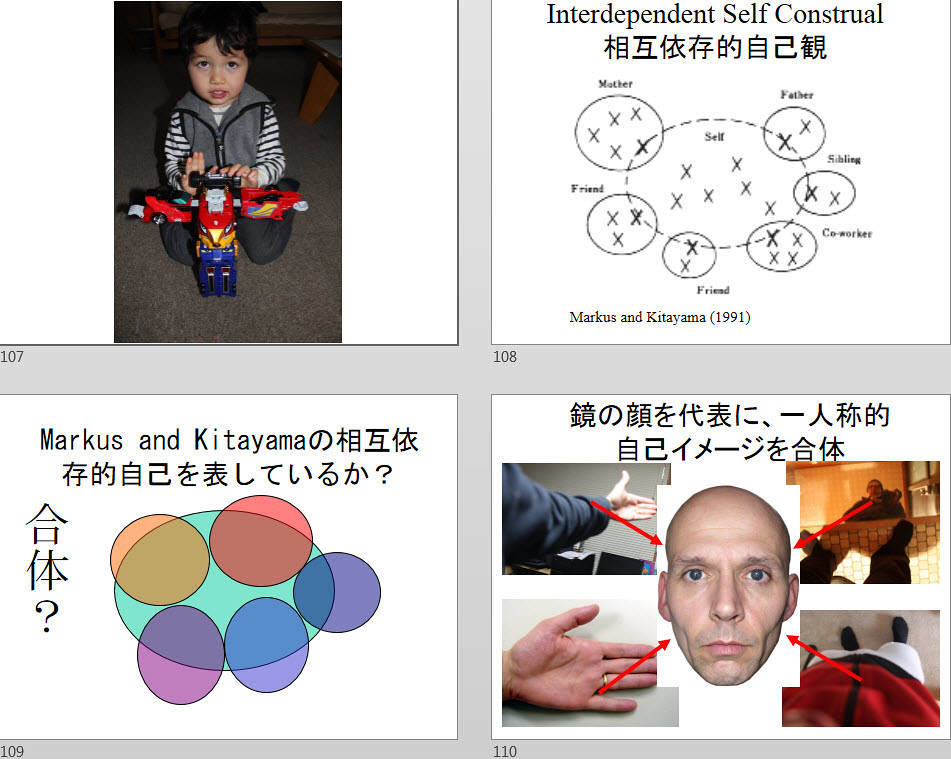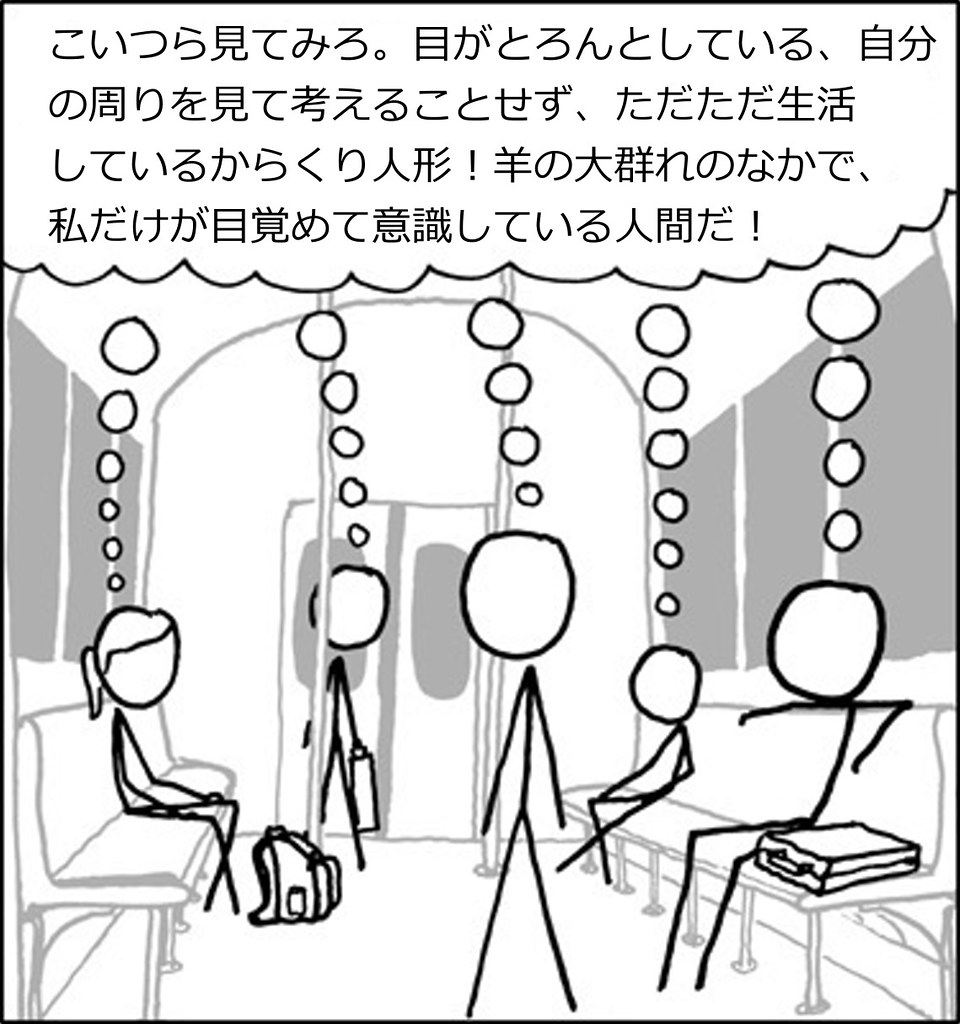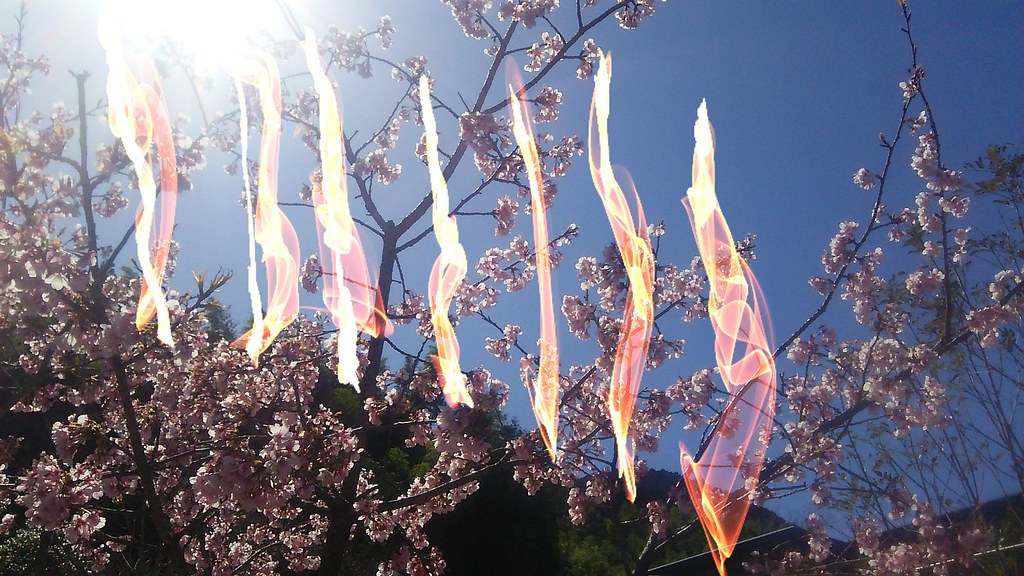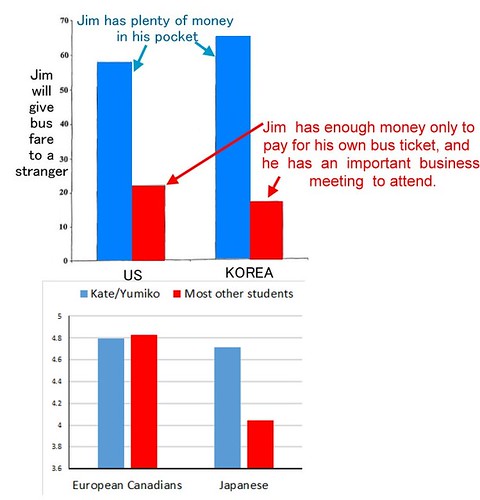Tuesday, April 26, 2016
Two Reasons For Gattai

Japanese superheroes are always merging, with an ecstactic cry of "gattai!" This merging scene mesmerized Japanese children who rehearse similar using merging superhero toys. The merged superheroes are often much larger in size. Often its is the familiars of the super-heroes (as my son is holding top left) rather than the heroes themselves that merge. The superheroes themselves will then sometimes fly up inside the merged giant to control it. Since the superheroes are possesed by the familiars, receiving their super power from them, this tinal structure has the topography of a Klien bottle. In the past I had thought that perhaps the merging represented the way in which Japanese must merge multiple interdependent (Marks & Kitayama, 1991) or "dialogic" (Hermans and Kempen, Bakhtin, but in fact in the visual domain) self views from the view points of others, and, relatedly whether Japanese children are merging various self body views, perhaps also with that of their face as viewed in a mirror. I have more recently realised the enormous size of my first person body views and presume that this difference in scale explains the size differences between the superheroes before and after they merge. http://flic.kr/p/FFH3xk
Labels: blogger, Flickr, japaneseculture, nihonbunka, sentai, superhero, 日本文化
Thursday, April 21, 2016
Japanese Translation of Sheeple

This the above is a Japanese translation of this illustration where everyone on a train thinks that all the others present are sheeple. Research (Leuers = Takemoto & Sonoda, 1999) shows that Westerners do have a false uniqueness bias, whereas Japanese are more likely to believe that they are more normal than they in fact are. Leuers = Takemoto, T. R. S., & Sonoda, N. (1999). Independent self bias. Progress in Asian Social Psychology, 3, 87–104. Retrieved from http://ift.tt/1ScThyE http://flic.kr/p/GmP39M
Labels: blogger, culturalpsychology, Flickr, japaneseculture, nihonbunka
Tuesday, April 19, 2016
Spring Night's Dream

There is a Japanese saying "The proud don't last long, but are like a Spring night's dream." This proverb is often said to be the equivalent of "Pride comes before a fall," but it is more severe. According to the Japanese, the proud do not just fall, but disappear. In my pride, I feel I am really letting the Japanese down. My 'research,' which I tend to present only orally, claims that the Japanese too are very proud. While they don't say so, they see themselves, and present themselves, in a very positive light. Furthermore, many of Japanese including a majority of Japanese psychologists and their political leader seem to have been persuaded that they are lacking in pride and self confidence. To be proud and unaware that one is proud is a dangerous situation to be in, like being under the influence of alcohol unaware that someone has spiked your drink. So perhaps like the Heike, who were defeated just down the road, the Japanese may be in for some very bad news. In my pride and delusions of grandeur I feel I really need to try much harder to make the Japanese aware of their positivity so they do not let it blind them. Oh Japan, please take care. 驕る者久しくあらず(春の夜の夢のごとし)という日本語の格言があります。英語のPride comes before a fallに相当するものだといわれますが、日本の格言の方が厳しいですね。驕るもは「落ちる」のみならず、消えるとまで。 驕る私は日本人の厚恩にぜんぜん答えていないと思います。殆どが口頭発表という形のみで公開されている小生の研究では、日本人も誇り高いと主張しています。そうは言わずとも、日本人は非常に肯定的に自己視し、肯定的な形で視覚的に自己呈示すると思います。更に多くの日本の方、多くの日本の心理学者やその政治的指導者は、日本人には誇りと自信が足りていないと思わさされているようです。 驕りがあって驕りに気づいていないという状況は、ジュースだと思い込んでいる飲み物にアルコールを入れられて知らず知らず酔っている状態のように危ないでしょう。そう考えると、この近くで敗北した平家のように、日本人も悲報が届きそう。驕りと研究についての慢心のなか、目が見えなくならないように日本の方が日本型肯定的さに気づかれるようにもっと努力しなければならないと思っている今日です。 日本、気をつけてくださいm(._.)m http://flic.kr/p/GpvuHR
Labels: blogger, Flickr, japaneseculture, nihonbunka, 日本文化
Wednesday, April 13, 2016
Will Jim be Helpful?

Choi, Nisbett, and Norenzayan (1999) that when Americans and Korean's were asked whether an individual, "Jim", would help a stranger in the situation where Jim either has plenty of money in his pocket, or where Jim has money only enough for his own fare and an important meeting to go to, the Koreans were found to be more influenced by the situation as in the above graph (based upon Choi, Nisbett, & Norenzayan, 1999, fig. 1. p. 52). It is argued that Asians are more contextual basing their decisions, and predictions of other's decisions, upon the context of the action rather than the character of the individual.
The experimental evidence is persuasive, and it fits in with stereotypes of East Asian "collectivists", lacking gumption, blown by the winds of societal, and contextual pressure.
At the same time, there is something wrong with this picture. Firstly I find that Koreans and Japanese are notably helpful, and non violent, to strangers across situations rather than showing behavioural swings, the helpful to mean, as shown in the graph above.
I suspect that there is another reason why the Koreans are being more "context" sensitive and that is that they are given no information about Jim other than his name. If the Koreans were given an equal amount of information regarding Jim, such as "Jim is a suited 25 year old business man working for a provincial bank", say, then the they would have been no more swayed by the context than the Americans because they, like the Japanese, base their decisions upon what they can imagine, animating the visio-imaginable rather than the phoneme "Jim".
In support of this hypothesis in other research it was found that when given a little more information ‘‘Kate (Yumiko in Japanese) age 20, is a student at your university," (Hamamura, Heine, & Takemoto, 2007, p.250) was given to Japanese and Canadian students, it was the Japanese and not the Canadians that gave a more outlier - further from "most other students" - appraisal of ‘Kat/Yumiko's personality (graph above bottom, based on Hamamura, Heine, & Takemoto, table 1). This difference was significant (p<.001). This is because, I believe, in this experiment the subjects were not just given a name, but also some information upon which to imagine the person that they were appraising.
The Japanese mind does not make decisions in words (Kim, 2002), but upon the surface of its mirror (Timothy Roland Scott Leuers = Takemoto & Sonoda, 1998, 2000; T.R.S. Leuers = Takemoto & Sonoda, 1999; T. Leuers = Takemoto & Sonoda, 1999; Takemoto, T., 2002, 2003; T. Takemoto, n.d.; Timothy Takemoto, 2011a, 2011b, 2012a, 2012b, 2014).
Choi, I., Nisbett, R. E., & Norenzayan, A. (1999). Causal attribution across cultures: Variation and universality. Psychological Bulletin, 125(1), 47. Retrieved from citeseerx.ist.psu.edu/viewdoc/download?doi=10.1.1.316.410...
Hamamura, T., Heine, S. J., & Takemoto, T. R. (2007). Why the better-than-average effect is a worse-than-average measure of self-enhancement: An investigation of conflicting findings from studies of East Asian self-evaluations. Motivation and Emotion, 31(4), 247–259. Retrieved from link.springer.com/article/10.1007/s11031-007-9072-y
Heine, S. J., Takemoto, T., Moskalenko, S., Lasaleta, J., & Henrich, J. (2008). Mirrors in the head: Cultural variation in objective self-awareness. Personality and Social Psychology Bulletin, 34(7), 879–887. Retrieved from www2.psych.ubc.ca/~heine/docs/2008Mirrors.pdf
Kim, H. S. (2002). We talk, therefore we think? A cultural analysis of the effect of talking on thinking. Journal of Personality and Social Psychology, 83(4), 828. Retrieved from labs.psych.ucsb.edu/kim/heejung/kim_2002.pdf
Leuers = Takemoto, T. R. S., & Sonoda, N. (1998, October). 心像的自己に関する比較文化的研究(1) Cross Cultural Research on the Specular Self. Oral Presentation口頭発表 presented at the The 62th Annual Convention of the Japanese Psychologiocal Association English日本心理学第64回大会, Tokyo Gakugei Daigaku. Retrieved from nihonbunka.com/docs/shinzoutekijiko1.doc
Leuers = Takemoto, T. R. S., & Sonoda, N. (1999). Independent self bias. Progress in Asian Social Psychology, 3, 87–104. Retrieved from httyp://www.nihonbunka.com/docs/independent_self.rtf
Leuers = Takemoto, T. R. S., & Sonoda, N. (2000, November). 心像的自己に関する比較文化的研究(6) -メディア(言語とイメージ)の違いと日米比較― Cross Cultural Research on the Specular Self: Differences in Media (Language and Image) and comparison between Japan and America. Oral Presentation口頭発表 presented at the The 64th Annual Convention of the Japanese Psychologiocal Association English日本心理学第64回大会, Kyoto University. Retrieved from nihonbunka.com/docs/shinzoutekijiko6.docx
Leuers = Takemoto, T., & Sonoda, N. (1999). The eye of the other and the independent self of the Japanese. In Symposium presentation at the 3rd Conference of the Asian Association of Social Psychology, Taipei, Taiwan. Retrieved from nihonbunka.com/docs/aasp99.htm
Takemoto, T. (2002). 鏡の前の日本人. In 選書メチエ編集部, ニッポンは面白いか (講談社選書メチエ. 講談社.
Takemoto, T. (2003). 言語の文化心理学―心の中のことばと映像(The Cultural Psychology of Language: Language and Image in the Heart). In 武本, ティモシー & 古賀,範理, あなたと私のことばと文化―共生する私たち―. 五絃舎.
Tuesday, April 05, 2016
Doutaku and Doguu: Destroying the internal Other

Doutak bells are a quite mystery to me.
They are found dating from the Yayoi period when, I believe the previous, indigenous Japanese Joumon ("rope pattern") Japanese culture that had existed in Japan for millennia was invaded by horse mounted invaders from the continent. These bells were probably originally horse-bells, to allow horse mounted warriors to know where their horses are in the dark for instance. They started out being about the size of the bell that Ray is holding in the above photo, but were gradually made in larger and larger sizes.
My guess is that these larger and larger bells were in part to prove regal (or invader) hereditary, "My father or (great great..) grandfather was a horse mounted warrior." And with each passing generation the bells were made in larger sizes, perhaps.
The Japanese themselves have a tendency to believe that there was no "invasion" and that the Joumon people evolved into Yayoi people, and subsequently Kofun people, due to the arrival of "technology" from the continent rather than due to subjugation. The Japanese tend to believe, traditionally at least, imho, that their culture is continuous or contiguous from the year dot. And they may be right.
The genetic record however seems to point to a considerable differences (in height for instance) with at the same time much overlap, so at least there was interbreeding between an indigenous and arriving race. On the other hand, I suppose that genes might also be described as a "technology," and Japanese culture may have survived changes to the gene pool. I think it very likely.
I imagine Yayoi warriors arriving and breeding (no offence intended) with the indigenous Joumon people, and then later a second wave of invaders (related to the first) arriving in the Kofun (ancient burial mound) period. This two wave hypothesis is suggested by some (Korean) historical interpretations of Japanese mythology. After the latter wave vast tombs were created. The creation of vast tombs, all around Japan, makes me think that there was great stratification within society. I imagine that those that were related to the invaders rounded up and forced vast numbers of indigenous and mulatto stock Japanese and had them build tombs the size of the Egyptian pyramids for their new masters. But this is all my imagination. Korean and Western historians tend to present a sort of "Japan was invaded" type of history, whereas, as I say, the Japanese tend to portray their history as one of continuous evolution with changes in society being attributed to the arrival of new technologies such as for rice farming. I guess that the difference in historical outlook is one of degree. The Japanese are, and their culture is, great at maintaining continuity, of which a great deal remains. This post is about the possibility of continuity between doutaku (as held by my son Ray) and dogu (pictured above right).
Returning to the dotaku bells, they have peculiar characteristics. They appear to have been kept, while not in use, buried in the ground, being unearthed at specific occasions. One theory has it that they were buried in order to soak up and be replenished with the spirit of the earth. The bells often have pictorial inscriptions that may be rebuses, punning on that which they represent. They seem to have a lot of water related imagery and a preponderance of images of deer.
Ah yes, I remember now (I make the same observations over and over again): it seems to me that these doutaku bells may be the origin of the temple bells that are used to ring in the new year in Japan in the "joya no kane" (除夜の鐘) ritual, which are even more massive than the largest doutak. They look similar. They are likewise inscribed. These "joya no kane" bells are now associated with Buddhist ritual to purify the ringers of sins, of which there are said to be 108.
The "rope pattern", Joumon culture indigenous Japanese, who existed for millennia, seem to have created first person body view (McDermott, 1996) figurines or dogū (土偶) which have similarities with the Venus figurines found all over the palaeolithic world. These figurines in Japan were often destroyed. I wonder if they were destroyed (and perhaps buried) in an attempt to exorcise their owners from the mother that occupied their, and perhaps all our, minds.
If so then, by a vast leap of conjecture, it might be argued that the practice of making first person body view figurines and then breaking and burying them, may have evolved into the practice of making vast bells and ringing then (at first) burying them.
This conjecture parallels the hypothesis of Lacanian (and Freudian but less explicitly) psychology which has it that the self evolves by first being represented visually as a body view, then narrativally in phonemes.
In each stage the self is paired with an other-of-the-self that witnesses the self representation.
Lacanian psychology seems to lack reference to self-person body views. The visual or "mirror-stage" is purported to be one in which the the mirror self, or third person body image such as represented in mirrors, and the form of other children with whom infants identify, is seen from the perspective of real others and is therefore groupist, and interpersonal, rather than intra-psychic (in the mind).
It is only, according to Lacan and Mead, with the arrival of language that humans internalise an imaginary friend or Other or ear (of the Other). In Lacan and Mead, and Western philosophers in general, ears are argued to be internalisable but eyes are not. They claim that one can speak, whisper and eventually "think" in words to "oneself," or rather that hidden friend, a generalised other, super ego, super addressee. Eyes are always, interpersonal, groupist, social, out there in the world.
Till the discovery of mirror neurons, our paper on Mirrors in the Head, McDermott's first person, Nishida's Mephistopheles in 'active direct vision', and the lyrics of David Bowie ("Your Eyes" in Blackstar) it was not realised that people can create a watcher within their minds.
Western theorists seem to have missed out on autoscopic potential of the mirror neuron, or McDermottian possibility that eyes are just as internalisable.
Until recently I had thought that the "eye of the Other" was internalised in an abstract, ineffable way. Japanese pictorial art is often represented from the perspective of "an eye apart," typically looking down, from the sky such as one can experience when playing Mariokart, Final Fantasy or other third person view Japanese video games (Masuda, et al., in preparation).
At the same time however, it also seems possible to model an eye within the self in a more concrete way, as the the first person view of self, such as may be represented by dogū, and the first person view that we have of their own brow nose and limbs. When I look at myself in the mirror I can see the noses and brow of the person on this side of the mirror. I can hold out my hand and caresses the surface of the mirror. Narcissus is portrayed attempting to scoop up his image from the surface of water, using his this-side-of-the-mirror hands.
In a sense perhaps the phonic equivalent of the nose and brow is the voice. I can narrate myself and when I do, when I call myself names, such as "Tim" or "I," the in that situation, there is likewise a "this side of the mirror" in the voice that expresses these names. Mead, and Derrida, rightly point out that hearing oneself speak (s'entendre parler in Derrida) introduces a believable duality. But I think that Nishida is right to point out (at least I think he is pointing out) that a similarly believable, or en-actable (kouiteki) duality exists in seeing. Since we can see our brow, and our nose(s), and often our hands, we see ourselves see. We do not even need a mirror to do so.
So, aware of the fact that self always presupposes and entails a self loving drama (with [less than/not?] one actor and two personae), in an attempt to rid themselves of their self-loving sin, the Japanese may have moved from destroying images of the self-person view in the act of destroying and burying dogū figurines, to destroying the phoneme in the act of a DONNGG, of a doutaku or joya no kane bell.
One can hear the sound of a bell on the Japanese joya no kane wikipedia page and in this Youtube Video.
Bibliography
McDermott, L. R. (1996). Self-representation in Upper Paleolithic female figurines. Current Anthropology, 37(2), 227–275. websites.rcc.edu/herrera/files/2011/04/PREHISTORIC-Self-R...
I have also argued that Japanese attempted to destroy inner ears (converting them to external ones) by snapping their earrings. The more you love others the less you love yourself, and vice versa.
Labels: autoscopy, cultural psychology, image, japanese culture, Jaques Lacan, nihonbunka, psychology, religion, reversal, 宗教, 日本文化
This blog represents the opinions of the author, Timothy Takemoto, and not the opinions of his employer.
